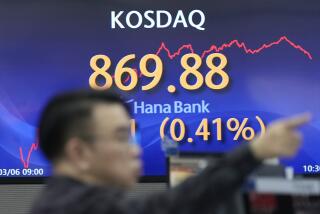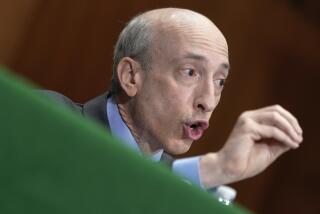SEC may take stock market tip from Australia
NEW YORK — Australian regulators might be paving the way for one solution that would prevent the kind of high-speed trading blunder that slammed Knight Capital Group: a “kill switch.”
The Australian Securities and Investments Commission this week proposed a set of requirements to halt runaway computer trading, including the introduction of an off switch that would immediately shut down programs. And regulators in the U.S. may consider similar safeguards.
It took Knight more than half an hour to finally gain control of a computer program that sent a torrent of errant trades into the market — a glitch that ultimately cost the company $440 million.
“Recent events overseas are a reminder of the speed and automation of markets and the importance of robust controls over those systems,” said ASIC Deputy Chairman Belinda Gibson.
The technology blunder has prompted other big Wall Street firms to look into beefing up their own systems, especially as the Securities and Exchange Commission and other regulators continue investigating what went wrong at Knight, according to trading software firm Mantara Inc. The company says about half a dozen trading firms have shown interest in software that would alert traders when algorithms don’t work as programmed and let them pull the plug.
“It’s a certainly a wake-up call,” Mantara Chief Executive Michael Chin said. Wall Street, he said, has become “so complex that some of the things you would think are so simple got lost in the complexity.”
U.S. regulators, meanwhile, are weighing what technology safeguards, if any, would prevent another trading debacle. Knight Capital’s stunning loss comes after two other recent high-profile Wall Street breakdowns: the failure of electronic exchange BATS to launch its own IPO in March, and the Nasdaq Stock Market’s botching of Facebook’s initial public offering in May.
“They need to have testing before their programs go live,” Bart Chilton, a member of the Commodity Futures Trading Commission, said in an interview. “They should have kill switches in case the programs go feral.”
The SEC has sped up efforts to propose a new rule to help prevent mishaps. It plans to hold a Sept. 14 forum on technology, trading and stability in the stock market.
The agency has been examining whether Knight violated regulations put in place after the May 2010 Flash Crash, when $1 trillion briefly vanished from the stock market. A focus of the agency’s review is the so-called market access rule, which in part requires firms such as Knight to take proper precautions before their systems trade in the marketplace, according to people familiar with the matter.
That rule requires broker-dealers to have procedures in place to prevent misfired trades, and the SEC is examining whether that rule needs to be tweaked, they said.
A proposed rule in the works could make mandatory certain elements of a now-voluntary program already in place called the Automated Review Policy, the sources said. That policy encourages — but doesn’t require — exchanges to perform stress tests as well as measure their trading capacity and security. A new SEC rule could mandate audits of technology platforms, for example, or involve new testing requirements for trading programs before they go live.
In the Knight case, which dragged on for about 45 minutes after the opening bell Aug. 1, traders could only watch as irregular trading roiled the market.
David Leinweber, who heads the Center for Innovative Financial Technology at the Lawrence Berkeley National Laboratory in Berkeley, has proposed requiring Wall Street firms to test algorithmic trading programs in an intensive simulation — similar to the types of tests used by NASA or the military.
Wall Street firms have no way to test how trading platforms will fare in the “large interconnected computer network” that Wall Street has become, Leinweber said.
“There’s no way for them to have a system that is a simulated version of the market,” he said. “They can do the best they can internally, but they don’t have the means to test it fully.”
James Angel, a professor of business at Georgetown University and an expert on stock market structure, said regulators ought to focus on safeguards because computers inevitably malfunction.
“Eventually there is going to be a glitch,” said Angel, who is also a director at Direct Edge, an electronic stock exchange in New Jersey.
Wall Street firms should also roll out new trading systems in stages, starting with test symbols, followed by stocks that trade heavily, then bigger-volume stocks before everything else, he said. “It’s clear that a gradual rollout would have been better,” Angel said.
Knight, for its part, has said little about its Aug. 1 glitch.
A Knight spokeswoman said the firm had retained “external advisors” as part of an “in-depth review” but would not comment further. Bloomberg News, citing anonymous sources, reported Tuesday that Knight’s glitch was related to old, dormant software that was accidentally awakened by the program.






